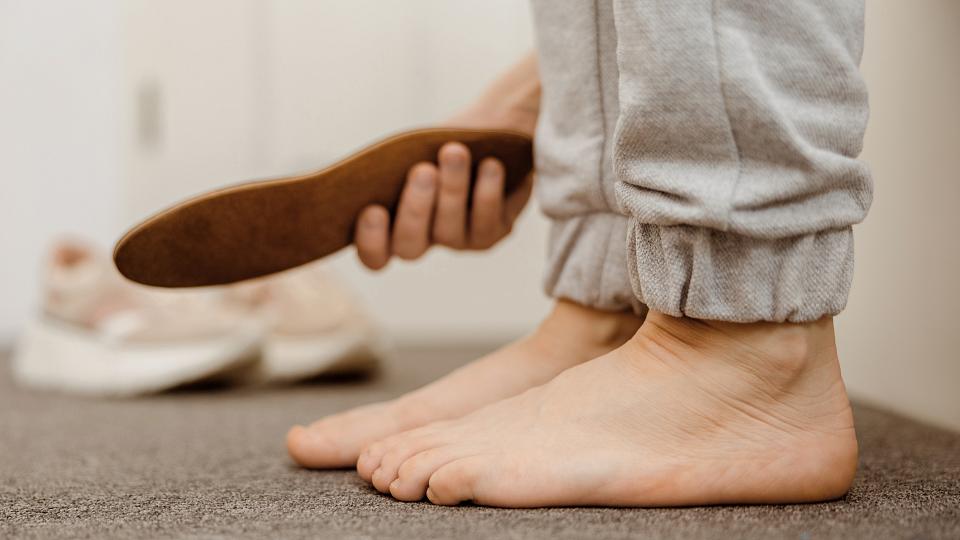
Treating Ankle & Foot Pain
Orthopedic providers at University of Utah Health are part of a team of internationally renowned experts who specialize in foot and ankle care. As part of an academic medical center, we work to remain on the cutting edge of the latest treatments, therapies, and more for foot and ankle pain. Many of our orthopedic surgeons also specialize in treating traumatic foot and ankle injuries.
Our team treats all types of foot conditions in collaboration with:
- orthopedic surgeons with advanced training in foot and ankle surgery,
- non-operative physicians and mid-level providers, and
- physical therapists.
Orthopaedic Injury Clinic
If you've injured your foot or ankle, our Orthopaedic Injury Clinic offers extended hours and walk-in availability for sports and other orthopedic injuries. Our providers at the walk-in clinic will treat your injury and refer you to an orthopedic foot specialist for follow-up care.
Ankle & Foot Pain Symptoms
Symptoms that indicate an injury or problem with your foot or ankle include:
- pain in your foot,
- inability to walk or put weight on your foot or ankle,
- swelling,
- bruising, or
- obvious deformity.
Chronic foot and ankle injuries may start slowly and progressively get worse over time. If your foot pain gets worse or does not improve with rest and activity modifications, schedule an appointment to see one of our orthopedic specialists.

Ankle & Foot Pain Causes
Our foot and ankle orthopedic specialists treat a variety of conditions:
- Achilles tendon rupture (injury to the thick band of tissue that connects your calf muscles to your heel)
- Arthritis (loss of joint space that can lead to pain and joint stiffness)
- Bone spurs (growths that can occur from arthritis, prior injury, or chronic overuse)
- Bone fractures (injuries that lead to breaks in your bone or small cracks due to overuse)
- Bunions (small bone growths that form on the lower joint of your big toe causing pain and pressure on your smaller toes)
- Bursitis (inflammation in the small fluid-filled sacs (bursa) that cushion your joints)
- Diabetic neuropathy (nerve damage in your feet caused by diabetes)
- Flat feet (when your entire foot touches the floor while standing)
- Foot deformities (deformities in the bones of your foot that can cause pain and improper positioning of the toes)
- Severe cases of gout in foot (a form of arthritis that can cause sudden and painful inflammation in the joints around your toes and ankle)
- Metatarsalgia (pain and inflammation on the bottom of several toes)
- Osteochondritis dissecans (bone and cartilage that becomes loose or unstable from an injury or from underlying genetic and developmental factors)
- Osteomyelitis (a bone infection that leads to pain, redness, and swelling in your foot)
- Plantar fasciitis (inflammation in the thick band of tissue that connects your heel bone to your toes called the plantar fascia)
- Sprains or ligament ruptures (an injury that occurs after your foot or ankle rolls or twists in an awkward way and stretches or tears ligaments that connect bones)
- Tarsal tunnel syndrome (a nerve that is squeezed or compressed along the inside of your ankle)
- Tendonitis (inflammation or irritation of one of the tendons in your feet)
- Tendon ruptures (an injury that causes the tendon to tear either partially or completely)
Diabetes & Foot Pain
People with diabetes are at higher risk of nerve damage that can affect their feet and cause foot pain, called diabetic neuropathy or peripheral neuropathy. You may have a harder time feeling sensations in your feet, which means your feet could get injured or develop sores that you do not feel. Cuts and sores may not heal quickly because diabetes may cause weaker blood flow to your feet. If left untreated, these conditions can lead to infections or other complications over time.
If you have diabetes and you experience a foot injury, schedule an appointment to see a foot and ankle provider immediately.
Find a Foot & Ankle Specialist
Ankle & Foot Pain Treatment
Our orthopedic specialists will work with you to create a treatment plan that may include a combination of the following treatments depending on your foot or ankle condition.
- Bracing or immobilization — We will use braces, boots, crutches, and scooters to protect your injured foot or ankle and take any pressure or weight off of your foot while it heals.
- Physical therapy — These exercises will improve your range of motion and strengthen the muscles and joints in your foot. Physical therapy can be done as a treatment on its own or in conjunction with surgery and other therapies.
- Injections — Cortisone injections to alleviate your pain.
- Foot and ankle surgery — Open or arthroscopic (minimally invasive) surgery to repair ligaments, tendons, or bones after an injury or to correct deformities. Recovery may take several weeks or months, depending on your injury and the type of surgery.
Ankle & Foot Pain Remedies
Some injuries and minor foot and ankle pain can be safely and effectively treated without surgery with:
- RICE (rest, ice, compression, elevation),
- NSAIDs (non-steroidal anti-inflammatory drugs), such as ibuprofen or acetaminophen,
- activity modification to avoid things that hurt your injured foot or ankle, and
- a brace or bandage that protects your foot or ankle while it heals.
If your foot pain is the result of wearing ill-fitting or improper shoes, getting better shoes can provide relief. Make sure your shoes are:
- stable,
- the correct size,
- wide enough to accommodate your foot, and
- long enough so they don’t pinch your toes or rub against your heel.
You may need to have your feet measured for the proper shoes as feet can change in shape or size over time.
Schedule an Appointment with a Foot & Ankle Specialist
Contact our Orthopaedic Services at 801-587-7109 to schedule an appointment with our orthopedic specialists.
You can also get a referral to see our orthopedic specialists from:
- your primary care provider,
- a provider in the urgent care or emergency room, or
- a provider at our walk-in Orthopaedic Injury Clinic.
Some insurance plans require that you get a referral from your primary care provider in order to see a specialist and have it covered under your plan. Check with your insurance carrier to find out if this is required with your plan and get a referral if necessary.





